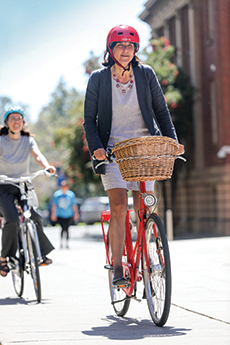On your bike, Adelaide

Dr Jennifer Bonham It could be argued that Adelaideans are easily influenced by all things wheels: the roar of V8 engines during the Clipsal 500 car race is echoed by rev-heads’ burn-outs in suburban streets; the rush of the peloton as it gusts by during the Tour Down Under stirs locals to squeeze into lycra and venture forth in their droves. For a couple of weeks at least.
And while it’s the car culture that has emerged victorious in Adelaide – as in so many other western cities over recent decades – it doesn’t have to be that way, according to the University of Adelaide’s Dr Jennifer Bonham.
A senior lecturer in Geography, Environment & Population, Dr Bonham is one of Australia’s leading researchers looking at issues of cycling and human mobility in urban areas. It’s her hope that Adelaide can become a great cycling city, helping to address a range of social problems along the way.
“Cities around the world are grappling with issues of traffic congestion and urban sprawl,” she says. “In most Australian cities there’s the question of: ‘Can we continue to expand into the urban outskirts, eating up agricultural land?’
“Once governments implement policies aimed at achieving higher urban densities, moving towards more compact cities, then we must accommodate more people on existing road infrastructure and, following from this, we need to diversify our travel options.”
Dr Bonham says in higher-density cities, cycling becomes a comfortable option for travelling distances of around 7.5km. “That’s what the Dutch refer to as a ‘short journey’,” she says.
The Netherlands is Dr Bonham’s shining example of a country that’s got its cycling policies and infrastructure right. In the 1970s, the Dutch started planning to become more heavily reliant on cycling. Now about one third of the population travels regularly by bike, and in cities such as Amsterdam more than 60% of journeys are made by bicycle.
“The Netherlands rejected what was going on elsewhere in the world, including Australia. We’d developed a culture in which car driving had become seen as the only viable mode of transport,” Dr Bonham says.
“In our society, cycling has been gradually marginalised out of mainstream transport. In the 1950s and ‘60s there were still a lot of people riding their bikes for everyday journeys but that was never included in any of the transport studies of the time.
“Over the years it’s become easy for motorists to think of the streets as their space alone, that cyclists don’t have a right to be there,” she says.
While the Dutch have led in this field, the Danish city of Copenhagen has around 50% of its population regularly cycling, with Strasbourg in France at around 30%. How does that compare with Adelaide?
“For the daily journey to work, less than 2% of people in Adelaide are cycling,” Dr Bonham says. “In some inner suburbs, of Unley and Norwood, you’ve still only got about 5-6% of people cycling to and from work. So while it seems like cycling is becoming more popular in Adelaide, we’ve still got a long way to go.
“That’s 5-6% of people cycling when there hasn’t been a lot of effort put into it. So if we were to take a concerted approach to the issue – such as improving infrastructure, improving regulations, and promoting cycling – things would change.”
Dr Bonham says Australian cities should be able to reach at least 15% of cycling participation. The City of Yarra in inner Melbourne is close to hitting that mark. “They’ve been working for more than a decade to ‘invert the hierarchy’ – rather than prioritising motor vehicles on the street, they’ve prioritised movement of pedestrians, cycling and public transport. These innovations are proving to be a success,” she says.
“In Adelaide, it’s not unrealistic to expect that within 20 years, 25-30% of inner suburban journeys could be made by bicycle. Adelaide could be an ideal cycling city, especially if we have good road design and good regulations.”
Dr Bonham is co-editor with Marilyn Johnson of a new book, Cycling Futures, from University of Adelaide Press. The book captures the current state of cycling research from Australia and New Zealand, with contributions from engineering, architecture, social sciences, the humanities, health, economics, and many other fields. Dr Bonham says she hopes the book “will give the broader community an idea of how serious this form of mobility is, and the knowledge that it’s here to stay”.
She’s also quick to point out that that there are many women who have a passion for cycling conducting research into this field. “Cycling in Australia is often considered a very masculine pursuit. In some sections of the community it’s still seen as ‘blokes in lycra on weekends’.”
And while the “lycra set” are often derided, what does Dr Bonham think of them?
She laughs. “Many people may not know this, but the lycra set are good for the local economy – just ask any café or bakery! And I think: at least they’re out there on bikes.”
|
|
Media Contact:
Media Office
Email: media@adelaide.edu.au
Website: http://www.adelaide.edu.au/news/
External Relations
The University of Adelaide
Business: +61 8 8313 0814
For more news on the research and educational achievements of the University & our alumni read the University's bi-annual magazine, Lumen.
|
|





